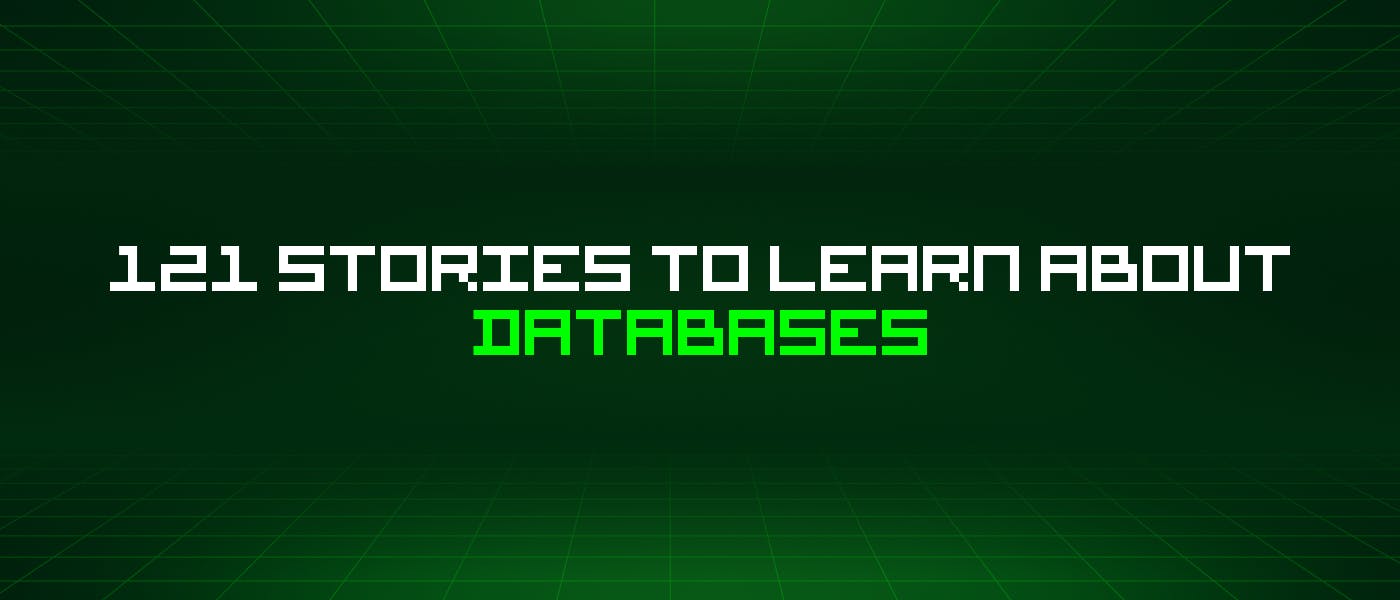Let's learn about Databases via these 121 free stories. They are ordered by most time reading created on HackerNoon. Visit the /Learn Repo to find the most read stories about any technology.
1. Why You Want Multi-Region Application Architecture for you Database
 Multi-region application architecture is a key way to solve a lot of potential headaches with globally distributed apps. It makes applications more resilien
Multi-region application architecture is a key way to solve a lot of potential headaches with globally distributed apps. It makes applications more resilien
2. 7 Database Optimization Best Practices for Django Developers
 In this article, we will be discussing the ways to optimize the database for speed in Django applications.
In this article, we will be discussing the ways to optimize the database for speed in Django applications.
3. An Introduction to Database Testing With an Example of MariaDB
 Here's an example of Database testing with the MariaDB Server, one of the most popular open-source relational databases.
Here's an example of Database testing with the MariaDB Server, one of the most popular open-source relational databases.
4. Object-Oriented Databases And Their Advantages
 Object oriented database is a type of database system that deals with modeling and creation of data as objects. The main advantage of this database is the cons
Object oriented database is a type of database system that deals with modeling and creation of data as objects. The main advantage of this database is the cons
5. How to Use Server-Sent Events (SSE) With FastAPI
 Server-sent events (SSE) is a way to send data to the browser without reloading the page.
Server-sent events (SSE) is a way to send data to the browser without reloading the page.
6. "Specified key was too long; max key length is 767 bytes" Error in Laravel
 One of these issues you might stumble across using the PHP framework Laravel is this one:
One of these issues you might stumble across using the PHP framework Laravel is this one:
7. How to Build a Data-Driven Product Using Metabase
 Metabase is a business intelligence tool that lets you access your data in a read-only manner.
Metabase is a business intelligence tool that lets you access your data in a read-only manner.
8. Understanding How UUIDs Save Time and Storage
 Learn more about the universally unique identifier (UUID) and how using UUID in your QuestDB instance can help reduce query time as well as save storage space.
Learn more about the universally unique identifier (UUID) and how using UUID in your QuestDB instance can help reduce query time as well as save storage space.
9. The Megashift Towards Decentralized Edge Computing
 Why do we need Edge Computing? Why is the cloud not the solution for everything? Why is Edge Computing adoption taking so long? What's the solution to it?
Why do we need Edge Computing? Why is the cloud not the solution for everything? Why is Edge Computing adoption taking so long? What's the solution to it?
10. Course Review - The Complete Web Developer in 2023: Zero to Mastery
 Are you someone who would like to learn Web Development, but don’t know where to start? Well, you are in the right place.
Are you someone who would like to learn Web Development, but don’t know where to start? Well, you are in the right place.
11. Use Database Transaction Logs to Implement Observer Pattern
 The best way to implement the observer pattern - using transaction logs of databases.
The best way to implement the observer pattern - using transaction logs of databases.
12. A Distributed SQLite - What Are the Possibilities?
 Canonical just did a very interesting thing to the venerable SQLite, one of the most used databases in the world, it is written in C, is small, tight and fast so it is common for applications to use it for structured storage on limited devices like mobile phones, IoT, etc.
Canonical just did a very interesting thing to the venerable SQLite, one of the most used databases in the world, it is written in C, is small, tight and fast so it is common for applications to use it for structured storage on limited devices like mobile phones, IoT, etc.
13. How to Manage Databases with CI/CD
 If you’re still doing manual migrations on the database you’re doing it wrong. Databases are as much part of the application as the code.
If you’re still doing manual migrations on the database you’re doing it wrong. Databases are as much part of the application as the code.
14. 10 Cool CI/CD Tools For Your Project
 Continuous Integration, shortly called ‘CI’ in DevOps is an important process or a set of processes that are defined and carried out as a part of a pipeline called Build Pipeline or CI Pipeline.
Continuous Integration, shortly called ‘CI’ in DevOps is an important process or a set of processes that are defined and carried out as a part of a pipeline called Build Pipeline or CI Pipeline.
15. How SQL Database Engine Work
 For now, I am assuming that you all know what is SQL or you have some experience with SQL or you are using SQL for many years. I know many people who know so much about SQL and even have created many projects based on SQL and they do not know what is SQL engine or how actually SQL database engine works. It’s obvious no one’s care about the internal working of SQL engine or something because without knowing How SQL works we can still create and access database using any SQL program.
For now, I am assuming that you all know what is SQL or you have some experience with SQL or you are using SQL for many years. I know many people who know so much about SQL and even have created many projects based on SQL and they do not know what is SQL engine or how actually SQL database engine works. It’s obvious no one’s care about the internal working of SQL engine or something because without knowing How SQL works we can still create and access database using any SQL program.
16. Replicate PostgreSQL Databases Using async Python and RabbitMQ for High Availability
 PostgreSQL replication using python and RabbitMQ for providing your database server with High Availability by easily making replicas of your master server.
PostgreSQL replication using python and RabbitMQ for providing your database server with High Availability by easily making replicas of your master server.
17. Sort Through Online Data via Web Scraping [101]
 How Can You Sort Through Online Data?
How Can You Sort Through Online Data?
18. How to Set Up a Dedicated Database Server for Analytics
 Have that old laptop that's just in the back of your closet? Figure out how to give it a new life!
Have that old laptop that's just in the back of your closet? Figure out how to give it a new life!
19. Build your Own Live Chart With Deno, WebSockets, Chart.js and Materialize
 We will build a simple dashboard app that displays data from a Deno Web Socket server.
We will build a simple dashboard app that displays data from a Deno Web Socket server.
20. Navigating the Vector Database Landscape
 Learn about the options for vector databases and how each works.
Learn about the options for vector databases and how each works.
21. 14 Open Source SQL Parsers
 Parsing SQL queries provides superpowers for monitoring data health. This post describes how to get started on parsing SQL for data observability.
Parsing SQL queries provides superpowers for monitoring data health. This post describes how to get started on parsing SQL for data observability.
22. How to Solve Race Conditions in a Booking System
 Race conditions in a database and how you can solve them using techniques such as pessimistic and optimistic concurrency control.
Race conditions in a database and how you can solve them using techniques such as pessimistic and optimistic concurrency control.
23. Build Data-Driven Web App Without Backend

24. PostgreSQL diff Explained

25. Exploring the CAP Theorem: The Ultimate Battle of Trade-Offs in Distributed Systems
 Consistency, availability, and partition tolerance are the three musketeers of distributed systems. They ensure that your system operates correctly.
Consistency, availability, and partition tolerance are the three musketeers of distributed systems. They ensure that your system operates correctly.
26. The Failed Promises of Extract, Transform, and Load—and What Comes Next
 Faster, Better Insights: Why Networked Data Platforms Matter for Telecommunications Companies
Faster, Better Insights: Why Networked Data Platforms Matter for Telecommunications Companies
27. 10 Minute Guide to Fixing Damaged SQL Databases - No Recovery Required!
 In this article, I covered the use of a freeware application called FDR which can help you recover corrupt or damaged MS SQL databases.
In this article, I covered the use of a freeware application called FDR which can help you recover corrupt or damaged MS SQL databases.
28. How to Use .populate() With mongoDB
 How to use populate() method with mongoDB to itch data across referenced collections
How to use populate() method with mongoDB to itch data across referenced collections
29. PostgreSQL vs. MongoDB: Evaluating Database Structure, Speed, and More
 Choosing a database can be scary as it’s nearly impossible to change once you’ve built on one. So which will you choose? PostgreSQL or MongoDB?
Choosing a database can be scary as it’s nearly impossible to change once you’ve built on one. So which will you choose? PostgreSQL or MongoDB?
30. CouchDB vs MariaDB- Which is better?
 In simple terms, a database is a collection of information. It is organized to ensure easy accessibility, management, and updates.
In simple terms, a database is a collection of information. It is organized to ensure easy accessibility, management, and updates.
31. Watch Out for Deceitful Data
 Nowadays, most assertions need to be backed with data, as such, it is not uncommon to encounter data that has been manipulated in some way to validate a story.
Nowadays, most assertions need to be backed with data, as such, it is not uncommon to encounter data that has been manipulated in some way to validate a story.
32. Building an Open Source Python Web API Using Django REST Framework (Part Two)
 There are no strict rules on how to plan your work, but scribbling your ideas in a notebook, organising your requirements, and even generating pseudocode helps.
There are no strict rules on how to plan your work, but scribbling your ideas in a notebook, organising your requirements, and even generating pseudocode helps.
33. Your CI System is a Terrible Compliance System of Record - Here are 5 Reasons Why
 Jenkins, GitLab, Travis, Circle CI are great for DevOps but not so great for your compliance records - here's why.
Jenkins, GitLab, Travis, Circle CI are great for DevOps but not so great for your compliance records - here's why.
34. SQLite vs Realm: Which Database to Choose in 2021?
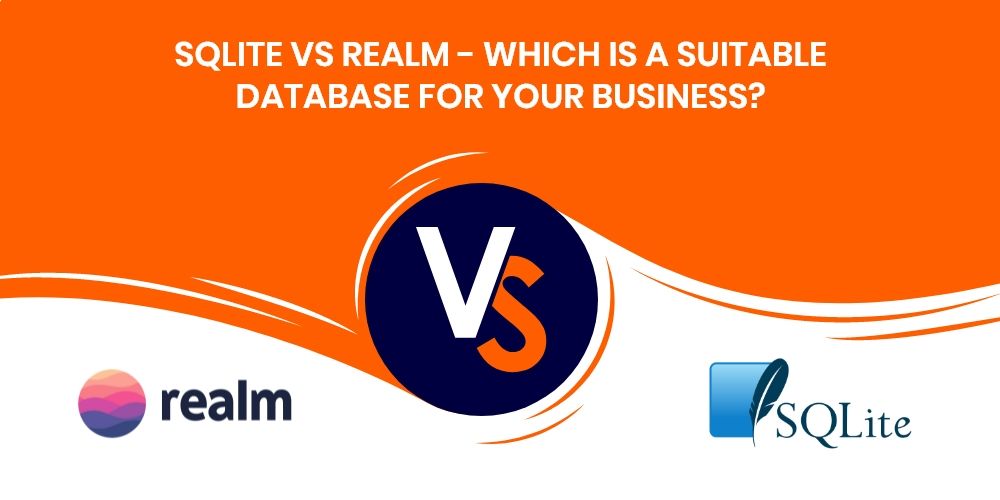 Image a situation wherein you have just launched your app. But the data of your app is not being properly displayed or you are not able to fetch the data that is being entered by the users. What will be the impression of your app in the user’s mind?
Image a situation wherein you have just launched your app. But the data of your app is not being properly displayed or you are not able to fetch the data that is being entered by the users. What will be the impression of your app in the user’s mind?
35. How to Enable MariaDB Replication: A Guide
 To set up replication for a new fresh MariaDB server, you can just enable the binary log in the primary and configure the connection in the replica.
To set up replication for a new fresh MariaDB server, you can just enable the binary log in the primary and configure the connection in the replica.
36. Creating a Dependable Data Pipeline for Your Small Business
 In this article, I will be showing you how to build a reliable data pipeline for your small business to improve your productivity and data security.
In this article, I will be showing you how to build a reliable data pipeline for your small business to improve your productivity and data security.
37. Six Ways For Effective Data Visualization With Tableau
 Tableau
Tableau
38. Getting started with Distributed SQL

39. Get Used to Building a .Net core MVC Application on Mac Visual Studio
 Creating .Net MVC project using Visual Studio Mac
Creating .Net MVC project using Visual Studio Mac
40. Intro to Databases: Using Different Data Models and Representing Databases Visually
 As you get into the Databases and Data Science, the first thing that you have to master is the relations between entities in your database. That is important because the data that you use has to be absolutely efficient for its further implementations.
As you get into the Databases and Data Science, the first thing that you have to master is the relations between entities in your database. That is important because the data that you use has to be absolutely efficient for its further implementations.
41. The Hyper-V Admins' Guide to VMware Backup
 The Hyper-V and VMware virtual environments may seem similar, but upon closer inspection, a number of important differences between these two platforms.
The Hyper-V and VMware virtual environments may seem similar, but upon closer inspection, a number of important differences between these two platforms.
42. Customizing MariaDB Docker Images
 How to customize MariaDB Docker images: Execute SQL and shell scripts when the containers start and pass configuration files.
How to customize MariaDB Docker images: Execute SQL and shell scripts when the containers start and pass configuration files.
43. Building the Next-Generation Data Lakehouse: 10X Performance
 How to connect various data sources easily and ensure high query performance.
How to connect various data sources easily and ensure high query performance.
44. How to Manage Multiple Databases in Rails 6
 With the launch of Rails 6, one of the new features that were announced was of multiple database support.
With the launch of Rails 6, one of the new features that were announced was of multiple database support.
45. Why Ruby Shall Still Be Relevant in 2021
 Ruby and the Rails framework are both under active development and regular updates are released for both all year round
Ruby and the Rails framework are both under active development and regular updates are released for both all year round
46. An In-depth Look Into MySQL Vs. PostgreSQL
 PostgreSQL and MySQL are both reliable, secure and scalable databases that have been around for years.
PostgreSQL and MySQL are both reliable, secure and scalable databases that have been around for years.
47. How to Handle Database Versioning on Multiple Environments

48. 6 Common DynamoDB Issues in 2022
 It’s expected that developers face many of the same issues when starting their NoSQL journey with DynamoDB. This article might clear things up a bit.
It’s expected that developers face many of the same issues when starting their NoSQL journey with DynamoDB. This article might clear things up a bit.
49. WunderBase - Serverless GraphQL Database on Top of SQLite, Firecracker and Prisma
 WunderBase is a Serverless Database with a GraphQL API on top of SQLite, Firecracker/Fly machines, and Prisma.
WunderBase is a Serverless Database with a GraphQL API on top of SQLite, Firecracker/Fly machines, and Prisma.
50. How to do Database Read/Write Splitting With Your Browser
 A tutorial that explains how a database proxy like MariaDB MaxScale serves as a transparent read/write splitter that scales SQL queries.
A tutorial that explains how a database proxy like MariaDB MaxScale serves as a transparent read/write splitter that scales SQL queries.
51. How to Erase Expired Docs Automatically with MongoDB (TTL index)
 Recently I needed to delete some documents that I saved in MongoDB after some time. I can think of a few examples of why we would want to delete data after some time:
Recently I needed to delete some documents that I saved in MongoDB after some time. I can think of a few examples of why we would want to delete data after some time:
52. Analyzing 110 Million Comments from Hacker News
 In this article, we’ll observe another test with1.1M Hacker News curated comments with numeric fields
In this article, we’ll observe another test with1.1M Hacker News curated comments with numeric fields
53. Create and Execute Stored Procedure in PHPMyAdmin

54. Blockchains: Beyond Vanilla Databases
 Was really confused whether to have the title as “Blockchain: Beyond a database” or “Blockchain: A combination of technology and social engineering” but decided on the former with the expectation that it might come easily in search engines.
Was really confused whether to have the title as “Blockchain: Beyond a database” or “Blockchain: A combination of technology and social engineering” but decided on the former with the expectation that it might come easily in search engines.
55. Maximize Cybersecurity with Multiple Databases
 If securing your company’s intellectual property is such a complex process, how can business leaders efficiently defend their assets? Use multiple databases.
If securing your company’s intellectual property is such a complex process, how can business leaders efficiently defend their assets? Use multiple databases.
56. How to Extract Insights From Your Data
 Manage data using the HarperDB database. Access your data from HarperDB using Custom Function. Automate EDA with data from the harperDB database using sweetviz.
Manage data using the HarperDB database. Access your data from HarperDB using Custom Function. Automate EDA with data from the harperDB database using sweetviz.
57. Hybrid Data Models: How To Have Your JSON Cake and Eat MariaDB Too
 By adding support for JSON, MariaDB provides the ultimate schema flexibility without sacrificing transactions or data integrity.
By adding support for JSON, MariaDB provides the ultimate schema flexibility without sacrificing transactions or data integrity.
58. Advanced and Efficient MongoDB Pagination
 How to make clean pagination with no additional dependencies. Basically for Node.js but can be used in any other languages and platforms.
How to make clean pagination with no additional dependencies. Basically for Node.js but can be used in any other languages and platforms.
59. Optimistic and Pessimistic Locking in JPA
 The article explains optimistic and pessimistic locking. We consider a Spring Data JPA application with concurrent transactional code as an example.
The article explains optimistic and pessimistic locking. We consider a Spring Data JPA application with concurrent transactional code as an example.
60. A Web3 Native Database: Tableland
 Smart contract developers need a web3 native database to decouple dapps and data. Tableland makes a nice try.
Smart contract developers need a web3 native database to decouple dapps and data. Tableland makes a nice try.
61. How to Create A Friendship Relation on Rails
 Engineering is about dividing problems into smaller partials. And then solving them with the best approach. As an engineer, I enjoy problem-solving.
Engineering is about dividing problems into smaller partials. And then solving them with the best approach. As an engineer, I enjoy problem-solving.
62. An Overview of SQL Antipatterns
 I was recently going through my notes of SQL Antipatterns and was shocked to realize how actual this book still is.
I was recently going through my notes of SQL Antipatterns and was shocked to realize how actual this book still is.
63. How to Avoid Inconsistency Across Microservices
 In a microservice architecture, you can get dependencies that impose restrictions on the services used
In a microservice architecture, you can get dependencies that impose restrictions on the services used
64. How to connect SuperTokens to a MySQL or to a PostgreSQL database
 Learn how to connect a self-hosted SuperTokens core to a database with or without Docker
Learn how to connect a self-hosted SuperTokens core to a database with or without Docker
65. How To Manage Sensitive Data Using SQL Data Discovery and Classification
 The 17.5 version of SQL Server Management Studio (SSMS) brought with it a new built-in security tool. Since then, the Data Discovery and Classification feature has become a difference-maker in the protection of sensitive information.
The 17.5 version of SQL Server Management Studio (SSMS) brought with it a new built-in security tool. Since then, the Data Discovery and Classification feature has become a difference-maker in the protection of sensitive information.
66. UUIDs Outshine Auto-Increment IDs and It’s Not Close
 People are still using autoincrementing integer ids in postgres in 2023 and they shouldn't be! UUIDs are leaps and bounds better.
People are still using autoincrementing integer ids in postgres in 2023 and they shouldn't be! UUIDs are leaps and bounds better.
67. Taking a Closer Look into Google's AlloyDB Architecture for PostgreSQL
 An exploration of AlloyDB's architecture and design, focussing on its storage engine, with descriptions of how it handles reads and writes
An exploration of AlloyDB's architecture and design, focussing on its storage engine, with descriptions of how it handles reads and writes
68. Collecting Data from 1.1M Hacker News Curated Comments
 In this test we use the data collection of 1.1M Hacker News curated comments with numeric fields from https://zenodo.org/record/45901.
In this test we use the data collection of 1.1M Hacker News curated comments with numeric fields from https://zenodo.org/record/45901.
69. Join to Write Data Into Your First Decentralized Database
 The DB3 Network is a start-up project to build a decentralized, permissionless platform for programmable data processing.
The DB3 Network is a start-up project to build a decentralized, permissionless platform for programmable data processing.
70. How to Make Rough Estimates of SQL Queries
 To do estimates of SQL queries we need to understand how DB works with queries. Let's find out what exactly the db do with queries.
To do estimates of SQL queries we need to understand how DB works with queries. Let's find out what exactly the db do with queries.
71. Deep Dive into the Implementation of Metadata Storage
 This article introduces the design and implementation of metadata storage in Alluxio Master, either on heap and off heap (based on RocksDB).
This article introduces the design and implementation of metadata storage in Alluxio Master, either on heap and off heap (based on RocksDB).
72. A Guide to Using MongoDB Database in a ASP NET Core Web API Application
 When you think about database providers for ASP NET Core apps, you probably think about Entity Framework Core (EF Core), which handles interacting with SQL databases. But what about the NoSQL options? A popular option for NoSQL is MongoDB. So in this article we're going to learn how to create a simple ASP NET Core CRUD API using MongoDB as the database provider.
When you think about database providers for ASP NET Core apps, you probably think about Entity Framework Core (EF Core), which handles interacting with SQL databases. But what about the NoSQL options? A popular option for NoSQL is MongoDB. So in this article we're going to learn how to create a simple ASP NET Core CRUD API using MongoDB as the database provider.
73. Protecting Your Supabase App With SuperTokens Authentication
 Learn reasons why you should choose SuperTokens as your auth provider and why it pairs so well with Supabase in protecting you and your online infrastructure
Learn reasons why you should choose SuperTokens as your auth provider and why it pairs so well with Supabase in protecting you and your online infrastructure
74. Active Record Associations in Rails: Beginners Guide
 As Ruby on Rails developers, we do not have to worry too much about the operations in the database due to the Object-Relational-Mapping or ORM. The ORM allows us to focus more on the logic of the business while it handles the operations with the database on our behalf.
As Ruby on Rails developers, we do not have to worry too much about the operations in the database due to the Object-Relational-Mapping or ORM. The ORM allows us to focus more on the logic of the business while it handles the operations with the database on our behalf.
75. The Rise of Reusable SQL-based Data Modeling Tools and DataOps services
 The resurgence of SQL-based RDBMS
The resurgence of SQL-based RDBMS
76. 5 Ways to Store Market Data: CSV, SQLite, Postgres, Mongo, Arctic
 What's the most efficient way to store market data? SQL or NoSQL? Let's compare 5 most common options and find out what is best.
What's the most efficient way to store market data? SQL or NoSQL? Let's compare 5 most common options and find out what is best.
77. PostgreSQL Transaction Isolation Levels with Go Examples
 Illustration composed from MariaLetta/free-gophers-pack, original gopher by Renee French.
Illustration composed from MariaLetta/free-gophers-pack, original gopher by Renee French.
78. JDBC Tutorial Part 3: How to Use Database Connection Pools
 Learn what database connection pools are, why you should use them, and how
Learn what database connection pools are, why you should use them, and how
79. How to Aid Disease Research with a Biomedical Knowledge Graph
 Building a biomedical knowledge graph using publicly available datasets to better aid disease research and biomedical data modelling.
Building a biomedical knowledge graph using publicly available datasets to better aid disease research and biomedical data modelling.
80. “I’m Too Small To Be Targeted,” Is No Longer A Valid Argument in 2021: A Database Security Checklist

81. Smart Contracts are NOT Databases
 If it is not going to be used by a smart contract, dump it in an event
If it is not going to be used by a smart contract, dump it in an event
82. JDBC Tutorial Part 1: How to Connect to a Database
 Learn how to use databases from Java
Learn how to use databases from Java
83. The Oracle Database Docker Image Can Supercharge Your DevOps Learning
 This is a tutorial on how to install, use, and patch the Oracle Database Docker Image. Docker is a PaaS that delivers software in packages called containers.
This is a tutorial on how to install, use, and patch the Oracle Database Docker Image. Docker is a PaaS that delivers software in packages called containers.
84. How I'm Engineering a Versioned Database Storage Engine for Byte-Addressable NVM
 Feel free to contribute on GitHub 💚
Feel free to contribute on GitHub 💚
85. Using AWS Macie To Classify Databases
 I'll show how to use Macie to scan any database, inclusive on-premises, to discover sensitive data on tables.
I'll show how to use Macie to scan any database, inclusive on-premises, to discover sensitive data on tables.
86. HarperDB is More Than Just a Database: Here's Why
 HarperDB is more than just a database, and for certain users or projects, HarperDB is not serving as a database at all. How can this be possible?
HarperDB is more than just a database, and for certain users or projects, HarperDB is not serving as a database at all. How can this be possible?
87. Spacecraft Engineering Models: How to Migrate UML to TypeQL
 How to map UML to TypeQL. Read how the European Space Agency migrated their spacecraft engineering models from UML to TypeQL for use in a TypeDB database.
How to map UML to TypeQL. Read how the European Space Agency migrated their spacecraft engineering models from UML to TypeQL for use in a TypeDB database.
88. How to Set up a Heroku Postgres Database with Librato
 In this article, you will learn how to set up a Heroku Postgres database with Librato for automated monitoring.
In this article, you will learn how to set up a Heroku Postgres database with Librato for automated monitoring.
89. How To Add Data Sensitivity Classification Command in SQL Server 2019
 For a database administrator, the common everyday practice involves running multiple operations targeted at ensuring database security and integrity. Thus, we shouldn’t overlook the importance of sensitive data stored in the database under any circumstances. In light of this, we are excited to demonstrate the new ADD SENSITIVITY CLASSIFICATION command introduced in SQL Server 2019, which allows adding the sensitivity classification metadata to database columns.
For a database administrator, the common everyday practice involves running multiple operations targeted at ensuring database security and integrity. Thus, we shouldn’t overlook the importance of sensitive data stored in the database under any circumstances. In light of this, we are excited to demonstrate the new ADD SENSITIVITY CLASSIFICATION command introduced in SQL Server 2019, which allows adding the sensitivity classification metadata to database columns.
90. Rails Migrations Are Not Scary [Beginners Guide]

91. How to Choose the Right Database for your Requirements
 Imagine — You’re in a system design interview and need to pick a database to store, let’s say, order-related data in an e-commerce system. Your data is structured and needs to be consistent, but your query pattern doesn’t match with a standard relational DB’s. You need your transactions to be isolated, and atomic and all things ACID… But OMG it needs to scale infinitely like Cassandra!! So how would you decide what storage solution to choose? Well, let’s see!
Imagine — You’re in a system design interview and need to pick a database to store, let’s say, order-related data in an e-commerce system. Your data is structured and needs to be consistent, but your query pattern doesn’t match with a standard relational DB’s. You need your transactions to be isolated, and atomic and all things ACID… But OMG it needs to scale infinitely like Cassandra!! So how would you decide what storage solution to choose? Well, let’s see!
92. Year of the Graph Newsletter, April 2020: Graphs Power Scientific Research; Business Cases
 Is there life after COVID-19? Of course there is, even though it may be quite different, and it may be hard to get there. But there’s one thing in common in the “before” and “after” pictures: science and technology as the cornerstones of modern society, for better or worse.
Is there life after COVID-19? Of course there is, even though it may be quite different, and it may be hard to get there. But there’s one thing in common in the “before” and “after” pictures: science and technology as the cornerstones of modern society, for better or worse.
93. I Made ChatGPT Act as a MariaDB Database
 ChatGPT is truly impressive. You can instruct it to do all sorts of things when they can be communicated in plain text.
ChatGPT is truly impressive. You can instruct it to do all sorts of things when they can be communicated in plain text.
94. 10 Steps To Digital Transformation While Simultaneously Cutting Costs
 Companies Must Transform Or Else (Photo by eelnosiva on Adobe)
Companies Must Transform Or Else (Photo by eelnosiva on Adobe)
95. Heroku Guide: How to Go Live with your Rails App
 YAML: literally meaning “Yaml ain’t markup language” can mess you up in the beginning. Rails generates this file for you and you have to change it for Heroku. YAML spacing has to be exact and it’s important to know a tab is not the same as four spaces.
YAML: literally meaning “Yaml ain’t markup language” can mess you up in the beginning. Rails generates this file for you and you have to change it for Heroku. YAML spacing has to be exact and it’s important to know a tab is not the same as four spaces.
96. Learning Self JOIN Queries With SQLZOO
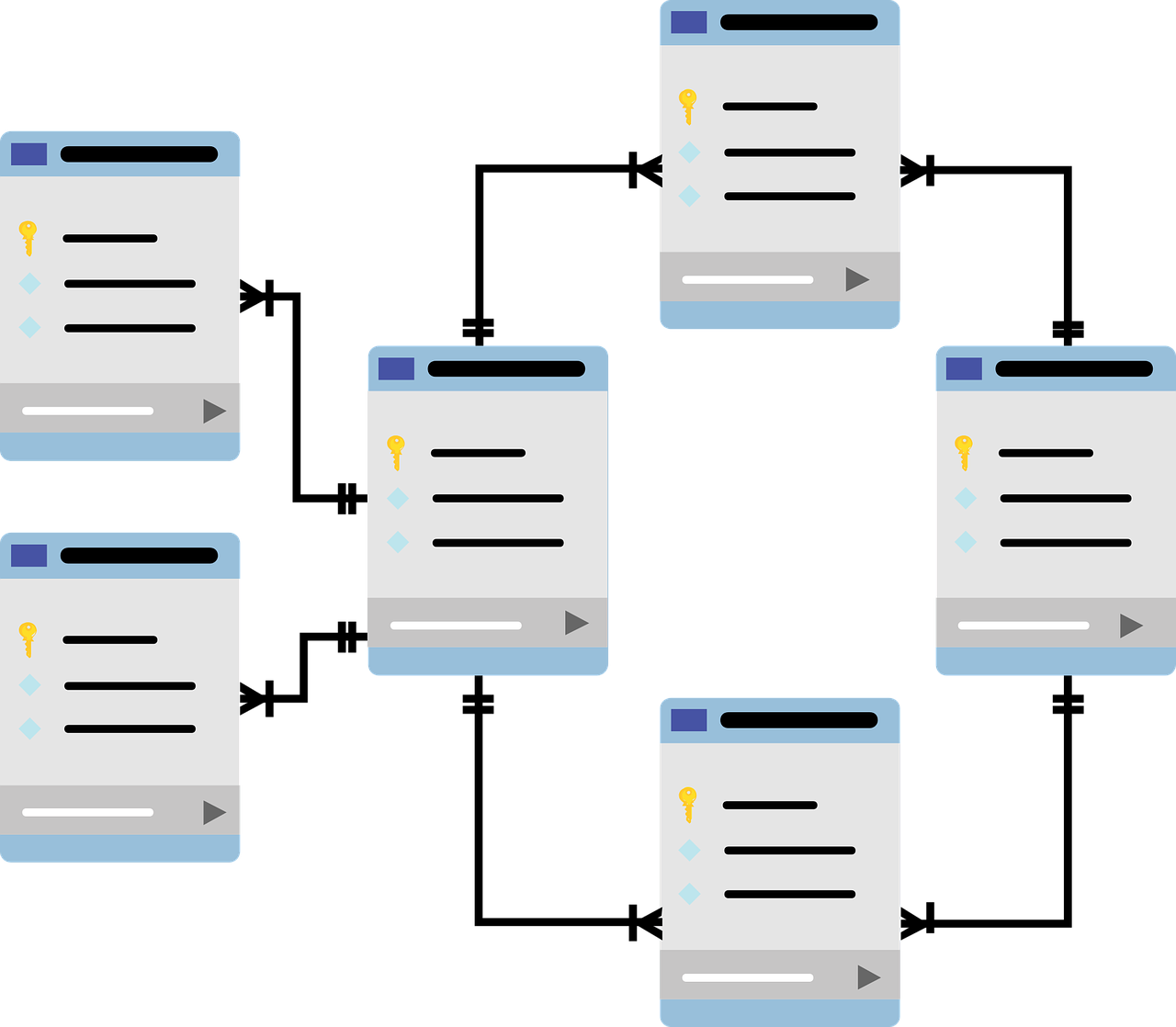 This article uses Exercise number 10 on the Self JOIN SQL ZOO tutorial to teach self JOINs in a beginner-friendly way.
This article uses Exercise number 10 on the Self JOIN SQL ZOO tutorial to teach self JOINs in a beginner-friendly way.
97. How to Add Knex to ExpressJS Apps and Connect to a Postgres Database
 Express is one of the most popular JavaScript frameworks for building backend APIs and Postgres is a really popular relational database. How do we connect them?
Express is one of the most popular JavaScript frameworks for building backend APIs and Postgres is a really popular relational database. How do we connect them?
98. How to Deploy Strapi v4 on the DigitalOcean App Platform with MySQL Database
 This is a step-by-step guide for deploying a Strapi v4 project to DigitalOcean's App Platform with managed mySql Database.
This is a step-by-step guide for deploying a Strapi v4 project to DigitalOcean's App Platform with managed mySql Database.
99. InfluxDB Continuous Downsampling - Optimize Your TSDB Today
 Introduction
Introduction
100. A Comprehensive Guide To Database Architectures And Use Cases
 This article will provide an overview on database architectures, including use cases and pros & cons for each of them.
This article will provide an overview on database architectures, including use cases and pros & cons for each of them.
101. How to Become a Backend Developer in 2020

All the app data is stored and processed on the back-end. Back-end development is everything that happens behind the scenes. It is a variety of things like the databases, the business logic, the API layer and pretty much everything other than the user-interface.
The average salary for a back-end developer is $123,689 per year in the United States as of 2019. In this post, let’s learn about what it means to be a Backend Developer.
102. Should You Be Using NoSQL?
 NoSQL got quite some hype a few years back. It was going to solve your scaling, uptime, and speed problems. There were trade-offs, of course, but, for a brief moment, seemingly everything we knew about storing and querying data was up for grabs.
NoSQL got quite some hype a few years back. It was going to solve your scaling, uptime, and speed problems. There were trade-offs, of course, but, for a brief moment, seemingly everything we knew about storing and querying data was up for grabs.
103. Top 10 Microsoft SQL Server Tips
 There is a lot of information about different T-SQL features.
I want to tell you about equally useful, but less popular tips for working with this language!
There is a lot of information about different T-SQL features.
I want to tell you about equally useful, but less popular tips for working with this language!
104. How to Convert Rest APIs into Databases: Create a JDBC driver
 A lot of data over the web or internally in an enterprise is available and accessible only through Rest APIs. Rest APIs do provide a secure and authenticated mechanism to access these services, but they are not very intuitive sometimes to query upon the data which is fetched through them.
A lot of data over the web or internally in an enterprise is available and accessible only through Rest APIs. Rest APIs do provide a secure and authenticated mechanism to access these services, but they are not very intuitive sometimes to query upon the data which is fetched through them.
105. How To Build An n8n Workflow To Manage Different Databases and Scheduling Workflows
 Learn how to build an n8n workflow that processes text, stores data in two databases, and sends messages to Slack.
Learn how to build an n8n workflow that processes text, stores data in two databases, and sends messages to Slack.
106. RocksDB Is Steadily Eating the Database World
 Technical design. Because one of the most common use cases of the new databases is storing data that is generated by high-throughput sources, it is important that the store engine is able to handle write-intensive workloads, all while offering acceptable read performance. RocksDB implements what is known in the database literature as a log-structured merge tree aka LSM tree.
Technical design. Because one of the most common use cases of the new databases is storing data that is generated by high-throughput sources, it is important that the store engine is able to handle write-intensive workloads, all while offering acceptable read performance. RocksDB implements what is known in the database literature as a log-structured merge tree aka LSM tree.
107. What a Strong Type System Brings to the Roche Drug Discovery Pipeline
 How a type system can bring speed and novelty to your discovery pipeline.
How a type system can bring speed and novelty to your discovery pipeline.
108. Hashicorp Vault max_ttl Killed My Spring App
 How to ensure that expiring Spring Cloud Vault dynamic database secrets are renewed, when reaching Hashicorp Vault’s max_ttl
How to ensure that expiring Spring Cloud Vault dynamic database secrets are renewed, when reaching Hashicorp Vault’s max_ttl
109. Apache Cassandra Guide: Data Modeling
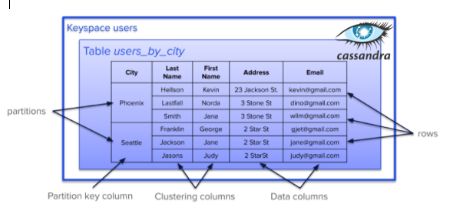 Data modeling is probably one of the most important and potentially challenging aspects of Cassandra. CQL will look familiar if you come from a relational background, but the way you use it can be very different. For our third guide, we will walk you through the process of creating a basic data model. Read part one on Cassandra essentials and part two on bootstrapping.
Data modeling is probably one of the most important and potentially challenging aspects of Cassandra. CQL will look familiar if you come from a relational background, but the way you use it can be very different. For our third guide, we will walk you through the process of creating a basic data model. Read part one on Cassandra essentials and part two on bootstrapping.
110. What Exactly Is Data Governance?
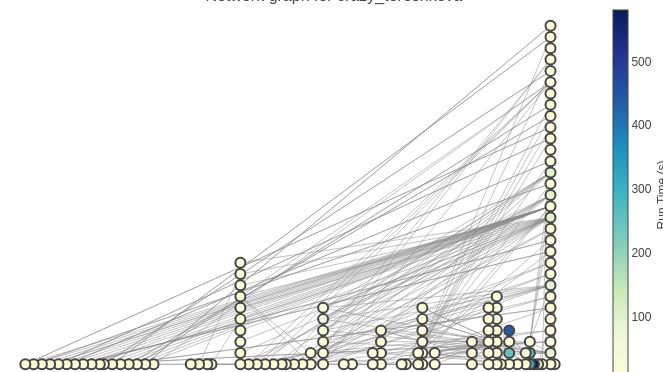 The first step is to understand what is data governance. Data Governance is an overloaded term and means different things to different people. It has been helpful to define Data Governance based on the outcomes it is supposed to deliver. In my case, Data Governance is any task required for:
The first step is to understand what is data governance. Data Governance is an overloaded term and means different things to different people. It has been helpful to define Data Governance based on the outcomes it is supposed to deliver. In my case, Data Governance is any task required for:
111. Fear database changes? Get them under control with CI/CD
 Developers often fear database changes because a mistake by anyone on your team can lead to a major outage and even data loss. The stakes are higher when changes are not backwards compatible, cannot be rolled back, or impact system performance. This can cause a lack of confidence and slow your team velocity. As a result, database changes are a common failure point in agile and DevOps.
Developers often fear database changes because a mistake by anyone on your team can lead to a major outage and even data loss. The stakes are higher when changes are not backwards compatible, cannot be rolled back, or impact system performance. This can cause a lack of confidence and slow your team velocity. As a result, database changes are a common failure point in agile and DevOps.
112. Bitcoin Doublethink.
 For some time now I’ve been making an unassailable and unchallenged argument that Bitcoin and Bitcoin services are no different to the monies and services found in video games. Now, thanks to my favourite gamer, we have one of the best examples yet of “Bitcoin Doublethink”, second only to the very cute Pigsby which uses a “Blockchain” for its database.
For some time now I’ve been making an unassailable and unchallenged argument that Bitcoin and Bitcoin services are no different to the monies and services found in video games. Now, thanks to my favourite gamer, we have one of the best examples yet of “Bitcoin Doublethink”, second only to the very cute Pigsby which uses a “Blockchain” for its database.
113. Digging into Postgres's Lesser Known Features
 Postgres Handles More than You Think
Postgres Handles More than You Think
114. How to Create World Leading Databases
 Jason Repp is the SVP of HarperDB, a world-leading database and development platform that is leading the charge in terms of performance, flexibility, and ease.
Jason Repp is the SVP of HarperDB, a world-leading database and development platform that is leading the charge in terms of performance, flexibility, and ease.
115. Apache Cassandra – Bootstrapping
 Our first article covered Cassandra essentials: the “what” and “why” about the architecture. If you’re ready to try Cassandra, the next few articles will explain the “how.” At the end of these tutorials you should have a database up and running, experienced using Cassandra Query Language (CQL), gained some practical data modeling expertise, and learned best practices for building applications with Cassandra.
Our first article covered Cassandra essentials: the “what” and “why” about the architecture. If you’re ready to try Cassandra, the next few articles will explain the “how.” At the end of these tutorials you should have a database up and running, experienced using Cassandra Query Language (CQL), gained some practical data modeling expertise, and learned best practices for building applications with Cassandra.
116. Data Scraping in Node.js 101
 How to gather data without those pesky databases.
How to gather data without those pesky databases.
117. Decentralized Databases Reduce Data Latency With Geographically Distributed Data Centers
 Latency is caused by offloading processing from an app to an external server. But what if there was a solution to the monolithic common single-cloud geography?
Latency is caused by offloading processing from an app to an external server. But what if there was a solution to the monolithic common single-cloud geography?
118. Setting up Continuous PostgreSQL Backups
 This manual describes the process of setting up continuous backups for PostgreSQL databases to safeguard your data from accidental loss in an efficient way.
This manual describes the process of setting up continuous backups for PostgreSQL databases to safeguard your data from accidental loss in an efficient way.
119. Heavy Rotation of Relational Hashicorp Vault Database Secrets in Spring
 Rotate Expiring Spring Cloud Vault Database Credentials Without Downtime
Rotate Expiring Spring Cloud Vault Database Credentials Without Downtime
120. Types Of Medical Databases And Their Benefits For Humanity
 What are medical databases?Medical Databases serve as an essential part in medical care, which includes the disciplines of research, documentation, patient care and treatment. The medical industry is constantly on the lookout for new medical applications, which would help improve their services. These endeavors are usually done through databases, which store data regarding diseases, diagnosis, treatments, medication, medical devices, medical practices and other pertinent details about medical professionals. With the constant advancements made in technology, these databases have also grown to be more technologically advanced and complex.
What are medical databases?Medical Databases serve as an essential part in medical care, which includes the disciplines of research, documentation, patient care and treatment. The medical industry is constantly on the lookout for new medical applications, which would help improve their services. These endeavors are usually done through databases, which store data regarding diseases, diagnosis, treatments, medication, medical devices, medical practices and other pertinent details about medical professionals. With the constant advancements made in technology, these databases have also grown to be more technologically advanced and complex.
121. Practical Microservices Development Patterns: CRUD Vs. CQRS
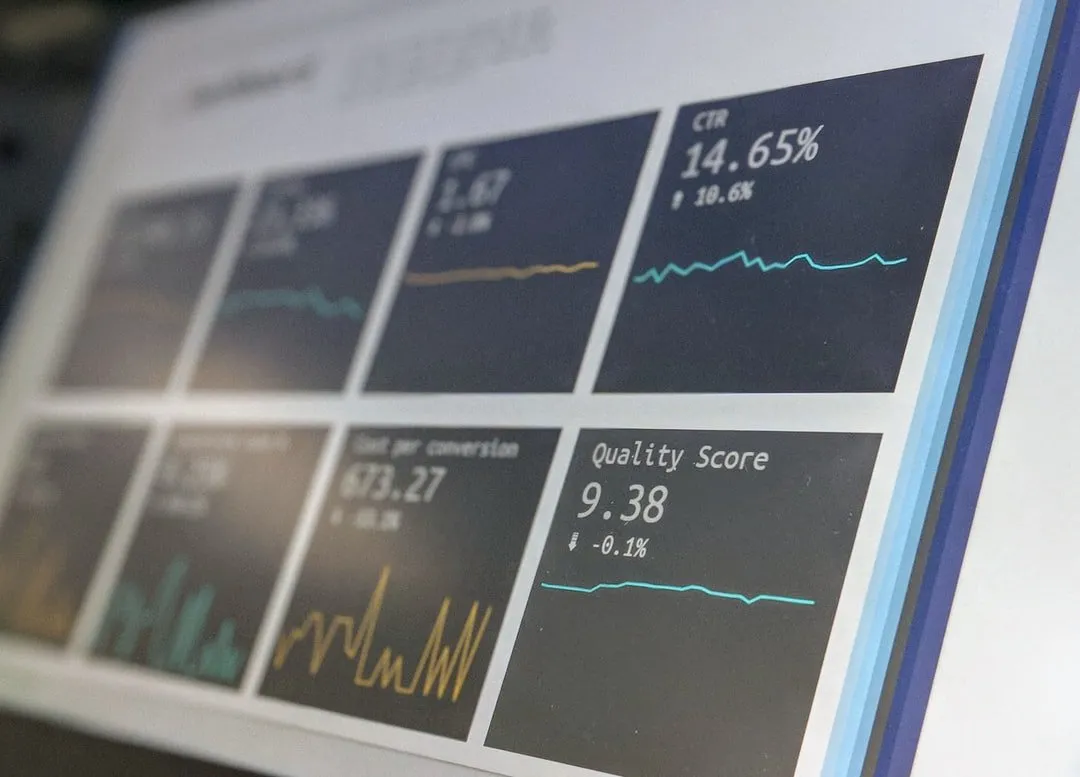 There are several patterns out there for handling data in microservices development. The most familiar one being the CRUD pattern.
There are several patterns out there for handling data in microservices development. The most familiar one being the CRUD pattern.
Thank you for checking out the 121 most read stories about Databases on HackerNoon.
Visit the /Learn Repo to find the most read stories about any technology.

